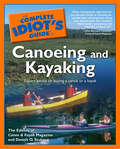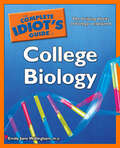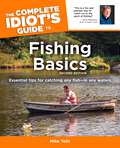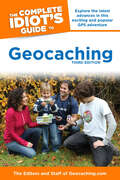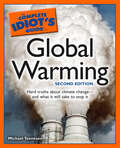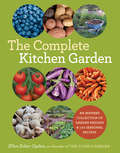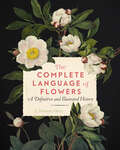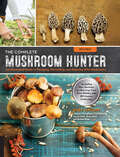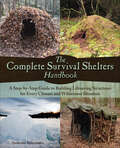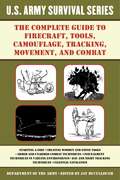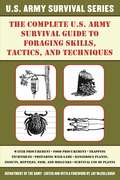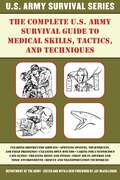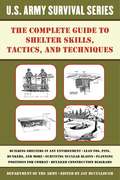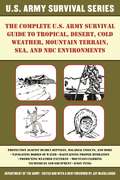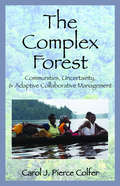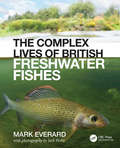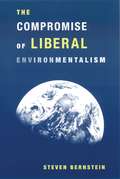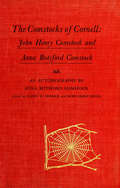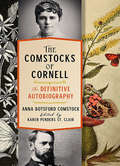- Table View
- List View
The Complete Guide to the National Park Lodges
by David L. Scott Kay Woelfel ScottFrom Alaska's Denali National Park Hotel to the lodges of Yellowstone National Park in Wyoming, this guide to US National Park lodges by a peripatetic Georgia accounting professor-school principal couple provides lodge descriptions, contact information, maps, and b&w illustrations. Lacks references. Annotation c. Book News, Inc., Portland, OR (booknews.com)
The Complete Idiot's Guide to Canoeing and Kayaking: Expert Advice on Buying a Canoe or a Kayak
by Canoe and Kayak Magazine Dennis StuhaugGo with the flow! You&’re no idiot, of course. You love being on the water and in the great outdoors. But when it comes to canoeing or kayaking, you&’re starting to think you hear a waterfall. Don&’t head for higher ground! The Complete Idiot&’s Guide® to Canoeing and Kayaking will prepare you for your journey—whether you&’re heading down a local river, around a regional lake, or into the ocean. In this Complete Idiot&’s Guide®, you get: • Detailed information on the different types of canoes, kayaks, and tips for choosing the right one for you. • Paddling strokes, maneuvers, and techniques for all kinds of conditions. • Foolproof tips on navigating all types of waters—from rough rapids to slow-moving streams. • Great advice on using kayaks and canoes for fitness, fishing, camping, and competition. Learn more about: • Safety considerations, including quick exits, Eskimo Rolls, swift water-rescue techniques, and more. • Safely paddling with kids, to make sure everyone has fun. • Clothing and equipment, including how to choose and care for a personal flotation device. • Paddling techniques and how they evolved through the years. • Planning a trip and choosing an outfitter or guide. • Building your own canoe or kayak.
The Complete Idiot's Guide to College Biology: The Building Blocks of Biology—Explained
by Emily Jane WillinghamBiology is the study of life—the structure, function, growth, origin, and evolution of living things. Biology and chemistry work together to create what many people think of as "science." And passing Biology 101 in college is the entryway to further study in the sciences - if you can't do well in it, you aren't moving ahead. The Complete Idiot's Guide® to College Biology follows the curriculum to Biology 101 so closely that it serves as a perfect study guide to it, and it's also great for the AP Biology and SAT Subject Biology exams that high school students are taking in droves. Students can turn to it when their textbooks are unclear or as an additional aid throughout the semester. The guide covers: • Complicated processes such as photosynthesis and cellular respiration • Explanations of complex biology, from DNA to ecosystems • Offers online extras, including a chapter on microbes and an extended glossary Suitable for the new learner or as a refresher for former students, The Complete Idiot's Guide® to College Biology brings biology to the reader in a relaxed, accessible way.
The Complete Idiot's Guide to Fishing Basics, 2E
by Mike TothYou&’re no idiot, of course. You know that the joy of fishing comes with skill, patience, and the right equipment. You can get yourself to the water and relax, but when it comes to baiting your hook and casting your cares away, you feel like a minnow swimming with the sharks!Don&’t throw back your angling ambitions just yet! The Complete Idiot&’s Guide® to Fishing Basics, Second Edition gives you the essentials for a successful fishing expedition—whether you&’re heading for the local creek or the high seas. In this Complete Idiot&’s Guide®, you get:• An emergency fishing guide to help get you started immediately• The lowdown on tackle—hooks, lines, sinkers, and more• All the right moves to feel, hook, play, and land your catch• The bottom line on what you&’ll need (and need to do) if you want to flyfish, saltwater fish, or fish in still waters
The Complete Idiot's Guide to Geocaching, 3rd Edition: Explore the Latest Advances in This Exciting and Popular GPS Adventure
by Editors & Staff Geocaching.comGeocaching has steadily grown into a fun and enduring outdoor adventure and with the popularity of GPS units and the development of applications for nearly all of the most popular smartphone platforms, it has become an adventure that's available to pretty much anyone. In The Complete Idiot's Guide® to Geocaching, Third Edition, the editors and staff of Geocaching.com open the world of geocaching up to a much broader audience and take the reader through all of the core essentials for caching including how to play, tips and tricks for finding and placing caches, variations on traditional caching, and much more. In addition, the reader can learn about exciting new changes to the game and the new GPS-enabled games that will take cachers to an entirely new level of fun and adventure.
The Complete Idiot's Guide to Global Warming, 2nd Edition: Hard Truths About Climate Change—and What It Will Take to Stop It
by Michael TennesenRevisiting the most important topic of our time The rapid warming of the Earth's climate has been a concern for decades. Though many of us understand that temperatures will-on average-rise, the science and the resulting social, economic, and political implications of such a change are far-reaching and complex. This new edition has been completely overhauled, synthesizing the latest information into an easy–to–read reference that provides a fair assessment of climate change, its costs, and even its short-term benefits.• Covers the newest science and issues surrounding global warming• Written by a seasoned science/nature journalist
The Complete Idiot's Guide to Hawaii: Your Ticket to the Worry-Free Vacation of Your Dreams
by Corey Sandler Michael RoneyAn indispensable resource for the perfect island getaway This reader-friendly guide to the beauty and wonder of the nation&’s 50th state features everything you need to know before visiting Oahu, Maui, the Big Island, Kauai, Molokai, and Lana&’i. Includes one-island and multiple-island itineraries, as well as ultimate itineraries for singles, families, couples looking for a romantic getaway, adventure seekers, and luxury lovers.• Special visual icons indicating hotels, restaurants, and sights that can&’t be missed—as well as those that are best avoided—make navigating the book simple• Features eight pages of beautiful full-color Hawaiian scenery
The Complete Idiot's Guide to Making Natural Soaps: Live Greener—and Cleaner—with Your Own Handcrafted Soaps
by Sally Trew Zonella B. GouldLeave no soapstone unturned! Soapmaking has always been a popular craft with a dedicated group of followers, but with the explosion of urban homesteading and people looking to go green, noncrafters are now joining in on the fun. Whether it's making natural soap to live greener, give as gifts, save money, or make money, The Complete Idiot's Guide® to Making Natural Soaps has everything the new soap maker will need to create organic, natural soaps of all kinds. • Includes recipes to make a wide array of molded, poured, and liquid soaps • Contains soap recipes for body as well as household and even pets
The Complete Kitchen Garden: An Inspired Collection of Garden Designs & 100 Seasonal Recipes
by Ellen Ecker OgdenA design and recipe resource with &“all the tools to plan a productive garden before seeds ever meet the ground&” (The Wall Street Journal). Based on seasonal cycles, each chapter of this indispensible book provides a new way to look at the planning stages of starting a garden—with themes and designs such as the Salad Lover&’s Garden, the Heirloom Maze Garden, the Children&’s Garden, and the Organic Rotation Garden. More than 100 recipes—including a full range of soups, salads, main courses, and desserts, as well as condiments and garnishes—are featured here, all using the food grown in each specific garden. &“There&’s no reason a vegetable garden must be an eyesore, banished to the corner by the garage. . . . The Complete Kitchen Garden . . . combines design advice, garden wisdom and recipes.&” —Chicago Tribune
The Complete Language of Flowers: A Definitive and Illustrated History (Complete Illustrated Encyclopedia Ser. #3)
by S. Theresa DietzA comprehensive encyclopedia providing the meanings, powers, facts, and folklore for over 1,001 flower species.For centuries, artists and lovers have used the secret language of flowers, or floriography, to discreetly send overt messages of their desires and emotions. A simple flower could reveal a variety of hidden meanings, from a flirtatious “I like you” to a serious declaration of everlasting love. For example:A sweet pea reported a friendly “I’m thinking of you”A lavender rose screamed “Love at first sight”Geraniums signified “friendship”Hibiscus wished “Peace and happiness”S. Thereesa Dietz has meticulously compiled over 1,001 of your favorite flowers into this beautifully updated and definitive guide, complete with full-color illustrations. Organized by both scientific and common names, each species contains fascinating and forgotten symbolic flower meanings from ancient Greek and Roman times to today. Whether used as a reference to create beautifully bespoke wedding bouquets or as a flower companion to plan stunning garden combinations, this comprehensive edition is perfect for every flower lover.“Flower lovers will marvel at S. Theresa Dietz’s The Complete Language of Flowers, an A to Z of flowers and plants listing symbolic meanings, possible powers, folklore and facts.” —BookPage
The Complete McAuslan: Stories From The Author Of The Beloved Flashman Series
by George Macdonald FraserGeorge MacDonald Fraser's hilarious stories of the most disastrous soldier in the British Army are collected together for the first time in one volume. Private McAuslan, J., the Dirtiest Soldier in the World (alias the Tartan Caliban, or the Highland Division's answer to the Pekin Man) first demonstrated his unfitness for service in The General Danced at Dawn. He continued his disorderly advance, losing, soiling or destroying his equipment, through the pages of McAuslan in the Rough. The final volume, The Sheikh and the Dustbin, pursues the career of the great incompetent as he shambles across North African and Scotland, swinging his right arm in time with his right leg and tripping over his untied laces. His admirers know him as court-martial defendant, ghost-catcher, star-crossed lover and golf caddie extraordinary. Whether map-reading his erratic way through the Sahara by night or confronting Arab rioters, McAuslan's talent for catastrophe is guaranteed. Now, the inimitable McAuslan stories are collected together in one glorious volume.
The Complete Mushroom Hunter: An Illustrated Guide to Foraging, Harvesting, and Enjoying Wild Mushrooms
by Gary LincoffThe only mushrooming book that will introduce you safely and with confidence to the not-so “underground” hobby of mushroom hunting and gathering.Gathering edible wild food is a wonderful way to forge a connection to the earth. Mushrooms are the ultimate local food source; they grow literally everywhere, from mountains and woodlands to urban and suburban parks to your own backyard. The Complete Mushroom Hunter will enrich your understanding of the natural world and build an appreciation for an ancient, critically relevant, and useful body of knowledge. Amateur mycologists and mushroom enthusiasts will find this is a guidebook for their passion.Mushroom guru Gary Lincoff escorts you from the mushroom’s earliest culinary awakening, through getting equipped for mushroom forays, to preparing and serving the fruits of the foray, wherever you live.Inside you’ll find:A brief, but colorful history of mushroom hunting worldwideHow to get equipped for a mushroom forayA completely illustrated guide to the common wild edible mushrooms and their poisonous look-alikes: where to find them, how to identify them, and moreHow to prepare and serve the fruits of your foray, plus more than 30 delicious recipesPlus, dozens of colorful, priceless anecdotes from living the mushroom lifestyle
The Complete Poems
by Wendy BarkerSpanning more than three decades of a life well-lived, Wendy Barker’s collected poems convey her encounters with the natural world, her reactions to contemporary social problems, and her experiences in high school and college classrooms. Adored by her students, many of whom became published poets themselves, Barker crafted verse that often recreated her presence in the classroom and her engagement with questions of identity, ethics, and the value of literature. Organized chronologically, this volume enables readers to marvel at the growth of a singular sensibility attentive to the wonders of love and the anguish of mortality. Edited by her husband, Steven G. Kellman, and featuring an introduction by acclaimed scholar and translator Ilan Stavans, Wendy Barker’s Complete Poems presents the life’s work of a steadily productive, brilliant poet and beloved teacher.
The Complete Survival Shelters Handbook: A Step-by-Step Guide to Building Life-saving Structures for Every Climate and Wilderness Situation
by Anthonio AkkermansThe ultimate guide to building protection from the elements, perfect for beginners and experienced outdoor enthusiasts alike. You can survive a couple of weeks without food and a few days without water, but in some cases, you would be lucky to survive one night without shelter. With structures ideally suited for any weather condition, this book presents emergency shelter designs built from a variety of elements, including 100 percent gathered items, a combination of natural and store-bought supplies, and even durable construction materials. The author offers helpful tips and techniques for mastering your shelter-building skills, as well as tutorials on how to make basic tools, bedding, mattresses, and other items to increase shelter comfort. Packed with easy-to-follow instructions and step-by-step photos, this all-encompassing primer teaches you how to construct a variety of lifesaving shelters, including: · Rock Shelter · Debris Hut · Lean-To · Bent Sapling Shelter · Snow Cave · Subterranean Shelter · Scandinavian Lavvu · Ger/Yurt · Basha/Tarp Shelter
The Complete U.S. Army Survival Guide to Firecraft, Tools, Camouflage, Tracking, Movement, and Combat (US Army Survival)
by Army Jay McCulloughIn this vital guide, you’ll find important techniques of wielding firecrafts, constructing tools, creating camouflage, and tracking a prey’s movement. From step-by-step instructions on crafting a flint knife to tips on beating an opponent in close combat, The Complete U.S. Army Survival Guide to Firecraft, Tools, Camouflage, Tracking, and Movement has got you covered. Within these pages you’ll find: Guidelines on selecting the best site to start a fire The most effective moves to use against an opponent in any range of combat How-to chose an optimal location for cover in any terrain Instructions for tracking the movement of dozens of different animals And dozens more critical techniques!With dozens of photographs and illustrations demonstrating techniques and procedures first-hand, this guide is an essential read for every outdoorsman-from the novice weekend camper to the most seasoned survivalist. If you can’t find it within the pages of The Complete U.S. Army Survival Guide to Firecraft, Tools, Camouflage, Tracking, and Movement, then you don’t really need it.
The Complete U.S. Army Survival Guide to Foraging Skills, Tactics, and Techniques
by Jay McCulloughHere in this critical guide is all the important foraging techniques that you’ll need to know in order to survive in just about any situation. From selecting edible berries to trapping small game, The Complete U.S. Army Survival Guide to Foraging Skills, Tactics, and Techniques has got you covered. Within these pages, you’ll find: The proper procedure to construct a water distillery How to discern the difference between poisonous and deadly plants. A step-by-step guide to expertly skinning and cooking a squirrel. And hundreds more critical foraging techniques.With dozens of photographs and illustrations demonstrating these medical techniques and procedures first-hand, this guide is an essential read for every outdoorsman-from the novice weekend camper to the most seasoned survivalist. If you can’t find it in The Complete U.S. Army Survival Guide to Foraging Skills, Tactics, and Techniques, then you don’t really need it.
The Complete U.S. Army Survival Guide to Medical Skills, Tactics, and Techniques (US Army Survival)
by Jay McCulloughHere in this critical guide is all the important medical techniques that you’ll need to know in order to survive in just about any situation. From wrapping life-threatening head wounds to treating a poisonous spider bite, The Complete U.S. Army Survival Guide to Medical Skills, Tactics, and Techniques has got you covered. Within these pages, you’ll find: First-aid techniques for hundreds of different kinds of wounds. Medical procedures necessary for properly treating animal bites and stings. Proper procedures to follow when dealing with toxic environments. And thousands more essential medical tips.With dozens of photographs and illustrations demonstrating these medical techniques and procedures first-hand, this guide is an essential read for every outdoorsman-from the novice weekend camper to the most seasoned survivalist. If you can’t find it in The Complete U.S. Army Survival Guide to Medical Skills, Tactics, and Techniques, then you don’t really need it.
The Complete U.S. Army Survival Guide to Shelter Skills, Tactics, and Techniques (US Army Survival)
by Jay McCulloughHere in this critical guide is all the important safety techniques that you’ll need to know in order to survive in just about any condition. From designing a makeshift earthquake shelter to constructing a water well, The Complete U.S. Army Survival Guide to Shelter Skills, Tactics, and Techniques has got you covered. Within these pages, you’ll find information on the best way to: Choose the best building materials. Select the best ambushing positions in any situation. Construct an underground bunker. And hundreds of more techniques and skillsWith dozens of photographs and illustrations demonstrating these sheltering techniques and procedures first-hand, this guide is an essential read for every outdoorsman-from the novice weekend camper to the most seasoned survivalist. If you can’t find it in The Complete U.S. Army Survival Guide to Shelter Skills, Tactics, and Techniques, then you don’t really need it.
The Complete U.S. Army Survival Guide to Tropical, Desert, Cold Weather, Mountain Terrain, Sea, and NBC Environments
by Army Jay McCulloughWithin this indispensable guide, you’ll find every tip that you’ll ever need to thrive in any type of landscape, in any degree of climate. From managing the heat of the tropics to combatting the chill of the mountaintops, The Complete U.S. Army Survival Guide to Desert, Forest, Jungle, Plain, Mountain, and Urban Environment has got you covered. Within these pages you’ll discover such vital tips as: How-to treat hypothermia The correct method of righting a capsized craft Tips for minimizing the dire effects of chemical exposure And dozens more crucial survival tips!With dozens of photographs and illustrations demonstrating these procedures and techniques first-hand, this guide is an essential read for every outdoorsman-from the novice weekend camper to the most seasoned survivalist. If you can’t find it in The Complete U.S. Army Survival Guide to Desert, Forest, Jungle, Plain, Mountain, and Urban Environment then you don’t really need it.
The Complete Walker IV
by Colin Fletcher Chip RawlinsFor the first time since 1984, we have a new edition of the classic book that Field & Stream called "the Hiker's Bible." For this version, the celebrated writer and hiker Colin Fletcher has taken on a coauthor, Chip Rawlins, himself an avid outdoorsman and a poet from Wyoming. Together, they have made this fourth edition of The Complete Walker the most informative, entertaining, and thorough version yet.The eighteen years since the publication of The Complete Walker III have seen revolutionary changes in hiking and camping equipment: developments in waterproofing technology, smaller and more durable stoves, lighter boots, more manageable tents, and a wider array of food options. The equipment recommendations are therefore not merely revised and tweaked, but completely revamped. During these two decades we have also seen a deepening of environmental consciousness. Not only has backpacking become more popular, but a whole ethic of responsible outdoorsmanship has emerged. In this book the authors confidently lead us through these technological, ethical, and spiritual changes.Fletcher and Rawlins's thorough appraisal and recommendation of equipment begins with a "Ground Plan," a discussion of general hiking preparedness. How much to bring? What are the ideal clothes, food, boots, and tents for your trip? They evaluate each of these variables in detail--including open, honest critiques and endorsements of brand-name equipment. Their equipment searches are exhaustive; they talk in detail about everything from socks to freeze-dried trail curries. They end as they began, with a philosophical and literary disquisition on the reasons to walk, capped off with a delightful collection of quotes about walking and the outdoor life. After a thoughtful and painstaking analysis of hiking gear from hats to boots, from longjohns to tent flaps, they remind us that ultimately hiking is about the experience of being outdoors and seeing the green world anew.Like its predecessors, The Complete Walker IV is an essential purchase for anyone captivated by the outdoor life.
The Complex Forest: Communities, Uncertainty, and Adaptive Collaborative Management
by Carol J. Pierce ColferThe Complex Forest systematically examines the theory, processes, and early outcomes of a research and management approach called adaptive collaborative management (ACM). An alternative to positivist approaches to development and conservation that assume predictability in forest management, ACM acknowledges the complexity and unpredictability inherent in any forest community and the importance of developing solutions together with the forest peoples whose lives will be most affected by the outcomes. Building on earlier work that established the importance of flexible, collaborative approaches to sustainable forest management, The Complex Forest describes the work of ACM practitioners facing a broad range of challenges in diverse settings and attempts to identify the conditions under which ACM is most effective. Case studies of ACM in 33 forest sites in 11 countries together with Colfer's systematic comparison of results at each site indicate that human and institutional capabilities have been strengthened. In Zimbabwe, for example, the number of women involved in decisionmaking soared. In Nepal, community members detected and sanctioned dishonest community elites. In Cameroon and Bolivia, learning programs resulted in better conflict management. These are early results, but a wide range of recent research supports Colfer's belief that these new capabilities will eventually contribute to higher incomes and to sustainable improvements in the health of forests and forest peoples. The Complex Forest reinforces calls for change in the way we plan conservation and development programs, away from command-and-control approaches, toward ones that require bureaucratic flexibility and responsiveness, as well as greater local participation in setting priorities and problem solving.
The Complex Lives of British Freshwater Fishes
by Mark EverardThis stunningly illustrated book goes far beyond a run-of-the-mill nature guide. It explores the fascinating life histories of Britain’s freshwater fishes, a group of animals which, despite their importance and ubiquity in our diverse still and flowing fresh waters, has before now been rarely regarded and respected as 'wildlife'. Our native fishes tend generally to be considered as simply something for anglers to catch or for people to eat, yet they work enormously hard for us. Author Mark Everard, avid nature-watcher, angler and scientist, shows how freshwater fish provide food, ornamentation, sport and cultural identity, and highlights their huge importance for conservation as part of the living ecosystems upon which we all depend. He dives into the mysteries moving below the surface of our rivers and lakes, bringing the wonderful and fascinating world of the diversity of British freshwater fish species into plain sight and into mind. This unique book features over 100 full-colour photographs by pioneering photographer and filmmaker Jack Perks, whose work has featured on BBC Springwatch, The One Show and Countryfile. The book is filled with technical detail useful to conservationists and biology students. Most importantly, it is also presented in an accessible, visually attractive and engaging manner that will appeal to anybody with an interest in the natural world: the conservation-minded public, the angling community, and our nation of wildlife enthusiasts. Whatever your background, this book will open your eyes to our freshwater fishy wealth, and the many ways in which it enriches our lives.
The Compromise of Liberal Environmentalism
by Steven BernsteinThe most significant shift in environmental governance over the last thirty years has been the convergence of environmental and liberal economic norms toward "liberal environmentalism"—which predicates environmental protection on the promotion and maintenance of a liberal economic order. Steven Bernstein assesses the reasons for this historical shift, introduces a socio-evolutionary explanation for the selection of international norms, and considers the implications for our ability to address global environmental problems.The author maintains that the institutionalization of "sustainable development" at the 1992 United Nations Conference on Environment and Development (UNCED) legitimized the evolution toward liberal environmentalism. Arguing that most of the literature on international environmental politics is too rationalist and problem-specific, Bernstein challenges the mainstream thinking on international cooperation by showing that it is always for some purpose or goal. His analysis of the norms that guide global environmental policy also challenges the often-presumed primacy of science in environmental governance.
The Comstocks of Cornell: John Henry Comstock and Anna Botsford Comstock
by Anna Botsford ComstockThe Comstocks of Cornell is the autobiography written by naturalist educator Anna Botsford Comstock about her life and her husband's, entomologist John Henry Comstock—both prominent figures in the scientific community and in Cornell University history.A first edition was published in 1953, but it omitted key Cornellians, historical anecdotes, and personal insights. Karen Penders St. Clair's twenty-first century edition returns Mrs. Comstock's voice to her book by rekeying her entire manuscript as she wrote it, and preserving the memories of the personal and professional lives of the Comstocks that she had originally intended to share. The book includes a complete epilogue of the Comstocks' last years and fills in gaps from the 1953 edition. Described as serious legacy work, the book is an essential part of Cornell University history and an important piece of Cornell University Press history.
The Comstocks of Cornell—The Definitive Autobiography: John Henry Comstock And Anna Botsford Comstock
by Anna Botsford ComstockThe Comstocks of Cornell is the autobiography written by the naturalist educator Anna Botsford Comstock about her life and that of her husband, the entomologist John Henry Comstock—both prominent figures in the scientific community and in Cornell University history. A first edition was published in 1953, but it omitted key Cornellians, historical anecdotes, and personal insights. In this twenty-first-century edition, Karen Penders St. Clair restores the author's voice by reconstructing the entire manuscript as Anna Comstock wrote it—and thereby preserves Comstock's memories of the personal and professional lives of the couple as she originally intended. The book includes an epilogue documenting the Comstocks' last years and fills in gaps from the 1953 edition. Described as serious legacy work, this book is an essential part of the history of both Cornell University and its press.

